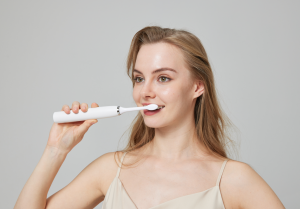Picture this: you grab your favorite mug of freshly brewed coffee, savor that first sip, and feel instantly awake. It’s a cherished morning ritual for millions. But as you glance at the bathroom mirror later, you might wonder… “Is my daily coffee habit dulling my smile?”
Let’s dive into the science behind coffee stains, compare them to other common offenders, and share five practical hacks—plus professional solutions—to help you keep your teeth bright. Whether you’re a casual sipper or a dedicated coffee aficionado, these tips will ensure your smile stays as energizing as your morning cup.

The Science of Coffee Stains
Chromogens: The Pigment Culprits
Coffee owes its deep color to chromogens—pigmented molecules that readily bind to tooth enamel. These high-contrast pigments can cling to microscopic pores in the enamel, creating that familiar yellowish tint over time.
- Molecular adhesion: Chromogens in coffee are large, ring-structured polyphenols that stick to enamel surfaces.
- Porous enamel: Enamel isn’t perfectly smooth; tiny pits and micro-grooves give chromogens a place to latch on.
Acidity: How pH Softens Enamel
Most coffee varieties have a pH between 5.0–5.5, which isn’t as acidic as red wine (around 3.5–4.0), but still low enough to soften enamel slightly. When enamel softens, its tiny pores expand, making it easier for chromogens to penetrate.
- Enamel demineralization: Acidic beverages can leach minerals from enamel, creating microscopic roughness.
- Increased porosity: Once softened, enamel retains more pigments during subsequent sips.
Saliva & Salivary Flow
Saliva naturally neutralizes acids and helps rinse away loose particles. However, if you sip coffee slowly over extended periods or consume multiple cups, saliva has less time to buffer acidity and wash away pigments.
- Low saliva flow: Factors like dehydration, certain medications, or early-morning dryness reduce saliva’s protective effect.
- Lingering pigments: Without adequate saliva, chromogens sit longer on the enamel surface, increasing stain potential.
Coffee vs. Other Common Stains
| Stain Agent | pH Range | Pigment Type | Relative Stain Score* |
|---|---|---|---|
| Red Wine | 3.5 – 4.0 | Anthocyanins | 10/10 |
| Coffee | 5.0 – 5.5 | Polyphenols | 8/10 |
| Tea | 5.0 – 5.5 | Tannins | 7/10 |
| Soy Sauce | 4.8 – 5.0 | Chromogens | 6/10 |
| Cola Drinks | 2.5 – 3.0 | Caramel Coloring | 5/10 |
*Stain Score combines acidity and pigment concentration for illustrative purposes.
5 Home Hacks to Zap Coffee Stains
Hack #1: Rinse or Swish Immediately
Why it works: A quick rinse with plain water or a fluoride mouthwash within five minutes of drinking coffee flushes away loose chromogens before they can embed in softened enamel.
- Pro tip: Keep a small travel-size fluoride rinse in your bag or keep a glass of water by your coffee station.
Explore our Fluoride Rinse Collection
Hack #2: Timing Your Brushing
Why it works: Brushing right after a cup can be harmful because acidic coffee softens enamel temporarily. Waiting 30 minutes allows saliva to remineralize enamel, reducing the risk of microabrasions when you brush.
- Science note: Saliva naturally raises pH and begins the remineralization process, fortifying enamel before any abrasive contact.
Pro tip: Set a timer or take a quick 5-minute walk after coffee. By the time you return, it’s safe to brush.

Hack #3: Use a Whitening Toothpaste
Why it works: Whitening toothpastes that contain baking soda, hydrogen peroxide, or mild silica abrasives break down surface pigments and gently polish away stains.
- Baking Soda: A gentle abrasive that helps scrub away surface staining without damaging enamel.
- Hydrogen Peroxide: Chemically breaks down pigment molecules.
- Silica: Provides light polishing to remove residual discoloration.
Check out our Whitening Toothpaste Collection
Hack #4: Snack on Crunchy “Natural Scrubbers”
Why it works: Foods like apple slices, carrot sticks, or celery act as natural toothbrushes. Their fibrous texture polishes the enamel surface while stimulating saliva flow, which helps rinse away pigments.
- Mechanical abrasion: Gently removes loose particles.
- Increased saliva production: Naturally flushes away chromogens.
Pro tip: Keep pre-cut crunchy snacks at your desk or in your kitchen so you can munch right after your coffee.
Hack #5: Weekly At-Home LED Whitening
Why it works: LED-activated whitening kits use a specific light wavelength (typically 450–490 nm) to accelerate the action of peroxide-based gels. Over time, this combination breaks down deeper-set chromogens that brushing and rinsing alone can’t remove.
IVISMILE’s Solution: Our IVI-12TW-K LED Whitening Kit features a 10% hydrogen peroxide gel optimized for coffee-stain removal and a 450 nm LED mouthpiece that enhances whitening efficacy in just 15 minutes per session.
When Home Hacks Aren’t Enough—Professional Solutions
In-Office Whitening vs. At-Home Kits
In-Office Treatments:
- Pros: Fast, dramatic results in a single visit.
- Cons: Higher cost, scheduling a dentist appointment.
At-Home LED Kits:
- Pros: Convenience, cost-effective for ongoing maintenance, can be used on your own schedule.
- Cons: Requires consistent use and adherence to directions.
Why Private-Label Brands Should Educate Consumers
Brands that share actionable tips about coffee-stain prevention build trust and drive engagement. By providing value-add content—like these “5 Hacks”—private-label lines can position themselves as experts. Plus, consumers who feel their brand cares about both enjoyment and oral health are more likely to stay loyal.
FAQs: Coffee & Your Smile
Q1: How quickly can coffee stain my teeth?
A1: While one cup won’t cause instant yellowing, daily coffee consumption can produce visible stains within 2–4 weeks. Our lab data shows a ΔE color shift of approximately 2.5 units on enamel after just one week of twice-daily coffee exposure.
Q2: Does adding milk or cream reduce coffee staining?
A2: Yes and no. Dairy can slightly lighten coffee’s pigment strength by diluting chromogens, but the underlying acidic pH still softens enamel. You’ll still benefit from rinsing or brushing at the right time.
Q3: Are charcoal toothpastes effective against coffee stains?
A3: Charcoal offers superficial polishing but is more abrasive than peroxide-based gels. Frequent use can increase enamel microabrasion. For safer, more reliable results, choose a formulated whitening toothpaste (like ours) that balances abrasives and chemical stain breakers.
Q4: Do LED whitening kits work on coffee stains?
A4: Absolutely—especially when paired with a peroxide gel designed for coffee pigments. Our IVI-12TW-K LED Kit achieves around an 80% reduction in coffee stains after a 15-minute session, thanks to optimized gel formulation and precise LED wavelength.
Q5: How often should I whiten if I’m a daily coffee drinker?
A5: We recommend an at-home LED session once a week for maintenance, combined with daily use of whitening toothpaste. If staining is severe, you can start with twice-weekly sessions until you reach your desired shade, then taper back.
Conclusion & Call-to-Action
Enjoying coffee doesn’t have to mean sacrificing your smile. By combining immediate post-coffee rinsing, intelligent brushing habits, whitening products, and professional-grade LED kits, you can keep your enamel bright and stain-free.
For private-label brands or OEM/ODM partners seeking to offer top-tier whitening solutions, IVISMILE provides end-to-end expertise—from custom gel formulation to wholesale LED kits—that stand up to coffee, tea, red wine, and more.
Ready to elevate your brand’s whitening lineup?
Request a free whitening sample and see how IVISMILE’s Kit can keep any morning smile shining.
Want to learn more about our OEM/ODM capabilities?
Contact IVISMILE’s R&D team for a customized consultation and private-label solution.
Keep sipping that coffee—your smile can stay bright, one hack at a time.
Post time: May-30-2025





